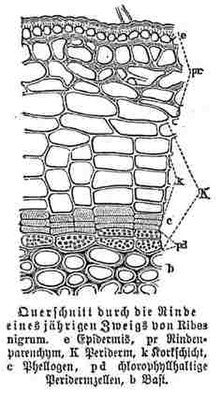Periderm
The periderm is the secondary closing tissue at the stem axis and the tertiary closing tissue in the root .
From the outside in, the tissue complex is composed of:
- Cork (phellem), dead, multilayered fabric
- Cork cambium ( phellogen ), single-layer meristem
- Phelloderm , a partially multilayered, parenchymatic , often photosynthetically active tissue
The walls of the cork cell are alternately impregnated with suberin and cutin .
Function and origin
The epidermis is often torn due to the secondary growth in thickness . Therefore, a second protective fabric ( secondary finishing fabric ) must be formed underneath. This function is taken over by the periderm.
In the cork cambium (phellogen), cork cells (phellema) are formed on the outside and small amounts of parenchymatic cells (phelloderm) on the inside.
The cork cells that are pushed off to the outside die because they can no longer get water through the medullary rays. They turn brown because they deposit bark pigments that serve as protection against rot.
In some trees, the first cork fabric remains permanently, they do not form a bark . They are also called periderm trees or bark trees. The best-known domestic representatives are the red beech , hornbeam , common hazel , rowanberry , as well as the currant and laburnum species.
Peridermia also play an important role in the formation of the bark .
See also
- Peridermröhre from chitin (from jellyfish )
literature
- Peter Schütt , Hans J. Schuck, Bernhard Stimm (Ed.): Lexicon of tree and shrub species. Special edition. Nikol, Hamburg 2002, ISBN 3-933203-53-8 , p. 328.
Individual evidence
- ^ A. Bresinsky, Ch. Körner, JW Kadereit, G. Neuhaus, U. Sonnewald: Strasburger - Textbook of Botany . 36th edition, Spektrum Akademischer Verlag, Heidelberg 2008. ISBN 978-3-8274-1455-7 , pp. 137f.
